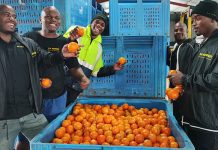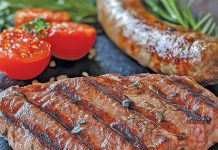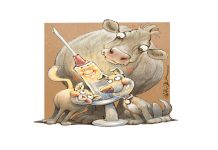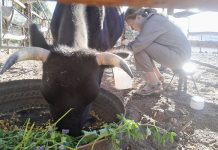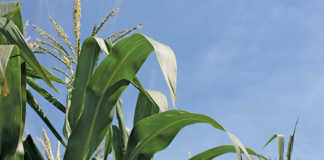
Photo: FW Archive
Heat stress in livestock poses a significant challenge for farmers, especially in regions with persistently high temperatures. As climate change exacerbates these conditions, it is becoming increasingly critical for farmers to recognise, manage and mitigate the impacts of heat stress to protect their livestock and maintain productivity.
Early signs of heat stress
Ranier van Heerden, business manager for ruminant solutions in sub-Saharan Africa at global chemicals company Evonik, says the early detection of heat stress in livestock is pivotal in mitigating its negative effects. Changes in behaviour are often the first indicators of heat stress.
“Animals will actively seek shade, pant excessively, and salivate more than usual. In dairy cows, a drop in DMI [dry matter intake] and [subsequently] milk production could be a clear sign,” he explains.
However, some of the subtler signs of heat stress can be difficult to detect. “Conditions like subacute ruminal acidosis in dairy cows, inflammation, insulin sensitivity and/or other metabolic disturbances often go unnoticed but can severely affect performance and reproduction. In addition, low conception rates and an increase in incidences of abortions are often observed,” he adds.
Environmental factors also play a key role in how heat stress manifests in different regions. Van Heerden says coastal areas with higher humidity levels pose different challenges when compared with inland areas.
“Humidity levels significantly impact how animals cope with heat stress, as high humidity reduces the body’s ability to efficiently dissipate heat through evaporation,” he explains.
Impact on productivity and reproduction
The physiological effects of heat stress are far-reaching and directly influence productivity and reproduction.
“When animals experience heat stress, their bodies normally prioritise survival over reproduction. This leads to decreased conception rates, delayed ovulation and, in some cases, infertility issues due to a change in the physiological status of certain parameters and rumen dynamics,” says Van Heerden.
Heat stress negatively affects feed intake. “Animals tend to reduce their DMI in high temperatures, which could result in increased fat utilisation for energy. This leads to elevated ketone levels in the blood, which in turn affects the quality of the ovum, embryo implantation, delayed oestrus and, ultimately, conception rates,” he explains.
Beyond these immediate effects, subclinical changes also have serious implications.
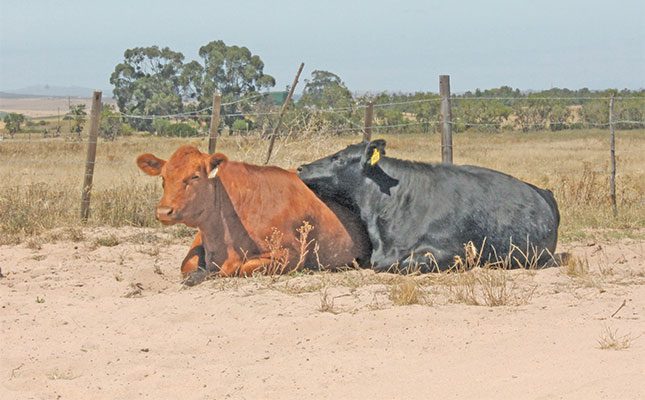
“Heat stress triggers internal changes, such as reduced blood pH, nutrient deficiencies, and electrolyte imbalances, all of which undermine the overall health and productivity of the animals,” adds Van Heerden.
He delves deeper into an animal’s physiological responses to heat stress: “As the animal’s body works to dissipate heat, blood flow is directed towards the skin, reducing circulation to vital organs like the udder, which in turn affects milk production.”
He adds that sodium bicarbonate is also lost through excessive salivation, which reduces the rumen’s ability to act as a buffer to the lower-pH environment, increasing the risk of subacute ruminal acidosis, which is a digestive disorder that affects dairy cattle.
“These physiological disruptions have cascading effects, from compromised calcium absorption to weakened immunity, making the animal more susceptible to infections and disease,” says Van Heerden.
Short- and long-term strategies
Farmers can implement several strategies to manage heat stress in their livestock. Van Heerden recommends focusing on environmental modifications and nutritional interventions to help animals cope.
“Providing [your animals with] adequate shade is essential. Farmers should also use cooling technologies like fans and water sprinklers,” he says. However, water droplet size and weight are crucial – if the mist is too fine, it can increase the level of humidity around the animal, thereby exacerbating the heat stress.
In addition, feeding should be planned for the cooler parts of the day to reduce the animals’ exposure to heat stress.
While immediate relief from heat stress is essential, Van Heerden mentions the importance of long-term strategies that focus on breed selection and ongoing nutritional management.
“Choosing cattle breeds that are more heat-tolerant – for example, the indigenous Nguni, Boran, and Afrikaner – can have long-lasting effects,” he says.
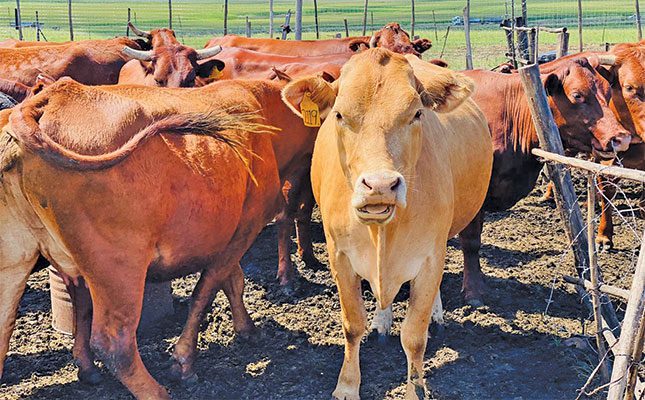
According to Van Heerden, breed selection should be guided by the specific climatic conditions of the farming area and specific selection criteria.
“Farmers need to consider environmental factors and select breeds that are genetically predisposed to withstand local heat conditions,” he explains.
The role of nutrition
In addition to environmental management, nutrition plays a crucial role in helping ruminants cope with heat stress. Van Heerden explains that the “heat increment” of different feeds – how much heat is produced after consumption – affects animals’ bodies in various ways.
“Heat is generated during the fermentation and digestion of feed. In warmer climates, it’s important to minimise this metabolic heat by choosing easily digestible feeds,” he says.
He adds that minerals like magnesium, sodium and potassium are particularly important for maintaining an animal’s electrolyte levels, which are disrupted by sweating and panting. Electrolytes play an important role in regulating fluid balance.
Technology and research
According to Van Heerden, there is potential for emerging technologies and research to improve heat stress management.
“Phytogenics, such as essential oils, botanicals and/or plant extracts, have shown promise in mitigating heat stress by helping to regulate body temperature,” he says.
He adds that there is ongoing research into selective breeding that is focused on adaptive traits to enhance heat tolerance in production animals.
On the technology front, he points out that tools like infrared cameras and rumen boluses can be very useful for large-scale farmers. These devices allow farmers to monitor animals’ body temperatures and hydration levels in real time.
However, Van Heerden notes that the cost of these technologies may be prohibitive for small-scale and emerging farmers.
“For [emerging farmers], simple solutions such as providing adequate shade, cool water, and appropriate mineral supplements are essential. Even basic measures like adding trees to create shade or placing water troughs in shaded areas can make a significant difference,” he says.
The emerging farmer
Van Heerden is passionate about supporting emerging farmers in managing heat stress. He says that because they often have fewer resources than commercial farmers, it is more difficult for them to put certain solutions into action.
That’s why it’s important for emerging farmers to get practical, tailored advice that fits their specific needs.
He recommends that they focus on low-cost interventions, such as affordable shade structures, strategic feeding practices, and the use of local mineral supplements.
“There is no one-size-fits-all solution, but by focusing on what’s practical and implementable, farmers can significantly reduce heat stress in their herds,” Van Heerden explains.
Managing heat stress in a changing climate
Heat stress is one of the most pressing challenges facing livestock farmers, particularly as global temperatures rise. However, with early detection, targeted interventions, and long-term strategies, its impact can be mitigated.
“For South African farmers, who face increasingly extreme weather conditions due to climate change, heat stress management is more important than ever,” he says.
Through proactive measures and ongoing research, farmers can safeguard animal health, improve productivity, and ensure the long-term sustainability of their operations. By investing in these practices now, they can mitigate the risks and thrive in the face of future challenges.
“Understanding heat stress and implementing effective strategies is not just a way to protect your livestock, but a way to secure the future of farming amid environmental challenges,” concludes Van Heerden.
Email Ranier van Heerden at [email protected].


